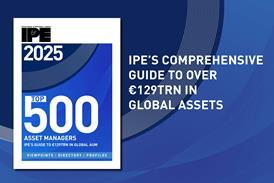There is now general agreement in the UK defined benefit (DB) pensions industry that we are moving towards much higher bond allocations and far lower equity allocations – the debate is largely on how long the transition will take. Furthermore, there is agreement on the major risks facing pension funds, including equity, inflation and interest rates.
However, disputes rage over the priority with which the risks should be addressed. This article highlights the subtle changes in mindset required to achieve liability matching, how these changes affect views on risk and how the differences can be reconciled.
The old adage was that pension liabilities should be matched with bonds because widows and orphans need conservative investment policies, while equities were appropriate for active members. Nowadays this is a puzzling argument because in DB schemes, widows and orphans’ benefits – like active members’ accrued benefits – are defined (like bond payments) and not dependent on investment policy. It is the pension scheme sponsor who largely bears the investment risk. Investing a fund in equities does not change the benefit promise. The old rule of thumb may have had substance when pension schemes were run like with-profit funds, but we are now in a post-Pensions Act 2004 environment.
Admittedly, some schemes also invested in equities to meet active liabilities because this policy was supposed to either match the liabilities (because equities supposedly grow with salaries) or reduce the cost of the liabilities (presumably because they don’t match the liabilities). Neither of these arguments seems convincing today.
Instead, pension schemes’ gradual move from equities to bonds actually reflects a change in mindset, from the pension fund as a risk-return portfolio to the pension fund as a vehicle for hedging liabilities. These two different mindsets arrive at different conclusions at any point on the path to full bond investment, although, fortunately, the impact diminishes as we converge on the endpoint. For example, the risk-return view takes account of risk premiums – such as the inflation risk premium (which may suggest holding fixed income rather than inflation-linked bonds), the term premium in bonds (one may take the view that this premium is negligible or even non existent beyond a certain term) or even the equity risk premium (the higher this is perceived to be the slower you the exit from equities). All these views are perfectly valid within the mindset of optimising risk-return as if the pension fund were a collection of individuals’ personal portfolios.
These views are not always easily reconciled with the perception of pension funds as hedging instruments – a view which, in theory, is blind to risk premiums and unconcerned with the optimal risk-return trade off. Although the shareholders of companies bear the pension fund risks, the hedging approach does not equate the way they arrange asset exposures with the way they choose to allocate their own portfolio. For example, a shareholder might not choose to hold a large US dollar exposure, but would still expect the company to hold a dollar reserve if it had large dollar liabilities. Similarly, the argument that nobody would choose to invest their personal portfolio 100% in bonds does not cut much ice as a reason for not doing this to hedge a pension liability. However, although blind to risk premiums, the hedging mindset is more finely tuned to the subtle aspects of investment, such as tax issues, transaction costs and, importantly, operational aspects. Indeed, corporate managers responsible for hedging activities may, at present, be far better equipped than a typical pension fund when it comes to such transactions.
This difference in mindset goes a long way to explain the divided opinion within the industry as to how pension funds should move towards matching their assets and liabilities. For instance, the key question of whether a pension fund should hedge its interest rate and inflation risks first and then look at reducing the equity allocation gradually or vice versa depends on how the problem is perceived – even though everyone might agree on the endpoint.
However, there is another issue driving the different views of pension funds, which can help to reconcile the two mindsets. This issue relates to whether trustees – given that many UK pension schemes are significantly insolvent on a buy-out basis – should be hedging the interest rate and inflation risks of the projected liabilities (often very long duration and strongly linked to inflation) or merely the priority liabilities (often moderate duration and weakly linked to inflation) covered by the existing assets. Some argue that, in terms of hedging liabilities, trustees’ duties end with the liabilities they can cover with the assets held. In particular, hedging unfunded liabilities may expose a scheme to an interest rate rise, further damaging its solvency position while, arguably, largely protecting the corporate from the effects of an interest rate fall.
In a framework where trustees focus purely on priority liabilities, the differences between the traditional approach to portfolio construction and the hedging approach are far less marked. In particular, inflation and interest rate risks do not loom as large in either mindset. Indeed, both sides might, rather ironically, agree on a path towards maturity that is not far from the traditional approach of simply matching current and deferred pensioners with fixed income bonds, and leaving the rest in
equities.
Of course, trustee focus on priority liabilities (covered by existing assets) does not address the risks associated with total liabilities faced by scheme sponsors. However, the difference between the two approaches simply arises from the unfunded deficit and this is a company liability (an effective asset of the scheme), so it would make sense for employers to be responsible for hedging it. Given companies’ greater familiarity with derivative instruments and the lower burden of paperwork involved in their implementing derivative solutions, there are obvious practical benefits to such an approach.
In the past, the idea of employers hedging pension liabilities on their own balance sheets was always rejected due to the different treatment of corporate and pension assets for accounting and rating purposes. Nevertheless, as the mark-to-market treatment of corporate derivative and pension assets coincides, and as pension debt and balance sheet debt become viewed as one, it becomes more feasible for corporates to consider doing some of the more technical hedging themselves. In the light of the bad press that some of these accounting and rating changes have generated elsewhere, perhaps this is the silver lining to the cloud.
Jon Exley is European partner at Mercer Investment Consulting jon.exley@mercer.com
www.mercerIC.com








No comments yet